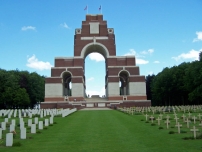| First Name: | Arthur | Last Name: | CROCKER | |
|---|---|---|---|---|
| Date of Death: | 16/09/1916 | Lived/Born In: | Queen's Park | |
| Rank: | Private | Unit: | London23 | |
| Memorial Site: | Thiepval Memorial, France | |||
Current Information:Enlisted-NW London
The Battle of the Somme (July-November, 1916) By the beginning of September, 1916, the Battle of the Somme had been raging for two months. Thousands of men had already been killed or wounded or were simply missing, never to be seen again and and just a few square miles of the French countryside, all in the southern part of the battlefield, had been captured from the enemy. Mistakes had been made by the various commanders and would be continued to be made but there was no turning back as the British, Australians, South Africans, New Zealanders and Canadians carried on battering away at the German defences in the hope of a breakthrough, So it continued all the way through to November with nearly every battalion and division then in France being drawn into it at some stage. In the end the German trenches had been pushed back a few more miles along most of the line but the cost in lives had been staggering. By the end of the fighting in November, 1916, British Army casualties numbered over 400,000, killed, wounded and missing. On 15th September, 1916, the offensive on the Somme was renewed with a full scale attack on the German 3rd line of defences. Four Army Corps were used on a front that stretched from Combles, through the village of Flers and on to Courcelette.. The artillery barrage that preceded this attack was more concentrated than that on 1st July and the attack itself was more successful. The villages of Flers, Martinpuich and Courcelette were captured and the enemy was finally pushed out of High Wood, but the breakthrough was not achieved and the reality was that when the battle ended on 22nd September, the front line had just been moved forward a mile or so. The battle is notable for being the first time that tanks were used. 47th (London) Division attacked at High Wood on 15th September with 140 and 141 Brigades. Within the wood itself the fighting was confused and bitter and progress was slow. Just to the east of the wood things went better and after capturing the Switch Line that lay on the reverse slope behind the wood, 140 Brigade moved further forward to capture a knot of trenches to the west of Flers called the ‘Cough Drop’. 142 Brigade were in reserve and it was not until the next day, 16th September, that 23rd London joined in the battle. At 8.55am they moved forward from Crest Trench. The reached the Switch Line in good order but then they were hit by machine-gun and artillery fire and became scattered and could only manage to occupy a knot of trenches called the ‘Starfish’. However one company was able to get further forward and reinforce 6th London in the ‘Cough Drop’. That night the attack was renewed and although they reached the low ground around the ‘Cough Drop’, they were then exposed to heavy fire from both flanks and from their own artillery as well. 23rd London’s casualty rate was very high. Hundreds were either killed, wounded or missing. One of these was Arthur Crocker. |
||||
| « Back to Search Results | ||||
| If you think any of the information shown here is incorrect, Click Here to submit your amends and comments | ||||




